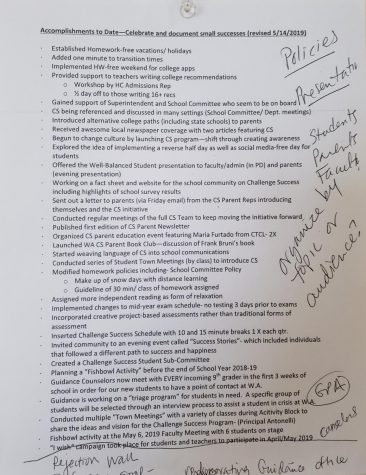WA takes measures to alleviate teacher stress
November 12, 2019
It’s a no-brainer that Westford is a highly competitive school district. While Westford students often feel stressed with their schoolwork and extracurriculars, their teachers often have the same, if not higher, levels of stress.
Recently, the Westford Education Association (WEA) conducted a survey among faculty members in which 83.3% of 257 teacher responders reported “yes” to the question “do you feel that workplace stress negatively impacts your job performance?” In other words, stressors in school impact many teachers’ abilities to effectively perform their roles.
However, with increased awareness of the prevalence of teacher stress, Westford Academy embarks on innovative measures to alleviate school-related stressors that may impede teachers’ instruction and mental health.
I. What is being done to reduce teacher stress?
According to the WEA teacher survey, the four most common comments staff gave as to what would help reduce their workplace stress were “smaller class sizes, fewer district/state initiatives and new curriculums, and changes to teacher education.” Superintendent Bill Olsen cites that the district is planning on using this survey as a basis for generating new larger-scale implementations to reduce teacher stress.
“As a district, there hasn’t been a lot done in terms of teacher stress, but the teacher’s union recently conducted a survey about teacher stress, and we will look at this to see what we can do to further address teacher stress,” Olsen said.
At a WA level, Principal James Antonelli has started taking some stress-reduction initiatives at WA.
“At the end of last year, I said ‘I want to focus on the faculty at Westford Academy, doing some little things to help you guys out.’ For example, relieving somebody from a duty, allowing some collaboration time during lunches, things like that,” Antonelli said.
One of these new initiatives includes the addition of the “Zippy’s” coffee maker in the teachers’ lounge.

Brochure of the Zippy’s machine
“Assistant Superintendent Cleary found the Zippy’s machine and it’s a great, fast coffee maker. I thought this would be a nice idea to reduce stress for people who work in the building. They’re staying late grading papers and stuff and you can’t grab a cup of coffee, and they don’t want to go to Dunkin Donuts because it’s not right next door,” Antonelli said.
Profits from the Zippy’s machine will be used in other initiatives to alleviate stress. So far, the machine has already produced $51 that will go toward these supplemental initiatives.
“We charge $1.25 per cup plus 25 cents, and the extra 25 cents is being put into the ‘Sunshine Fund.’ And at the end of the school year, we’re going to raffle off some gift certificates for teachers. So again, this one idea is going to kind of parlay into two ideas just to say, ‘hey, you know, you all contributed to this,’” Antonelli said.
Antonelli has also hosted multiple other teacher socials in past years such as a St. Patrick’s Day and holiday season event. A couple weeks ago, Antonelli also created the first annual Oktoberfest in place of this year’s first monthly department meeting, citing teacher stress as one of the main reasons of the creation.
“Teachers are basically in silos, you know, and you’re on this bell schedule and you’re like this hamster on the treadmill that is constantly stressed. What I loved about [the Oktoberfest] was that everybody was just relaxed and having conversations; you saw math teachers talking to English teachers, social studies teachers talking to science teachers, and it was just completely relaxed,” Antonelli said.
Additionally, committees such as Challenge Success reinforce the administration’s ideas of mindfulness and alleviating teacher stress. This past year, the committee created the “I Wish” campaign and a “Fishbowl Activity” as outlets for both teachers and students to express their own stressors they wished the other group would understand.
The Committee has also provided support for teachers writing college recommendations, such as providing them with a workshop by an admissions officer, as well as giving teachers who need to write over 16 recommendations half a day off.
President of the Challenge Success Committee Wendy Pechacek also cites how the committee has “assigned more independent reading as a form of relaxation” and has “inserted the Challenge Success Schedule with 10 and 15 minute breaks once a quarter when teachers do not have to offer extra help.”
According to Pechacek, Before the start of the ‘19-’20 school year, the Committee also redecorated a teacher meeting room to create a less stressful environment for teachers, and to remind them to slow down sometimes.

“Our committee meets regularly to talk about additional ideas to alleviate stress across the board. Recently, we have redecorated the guidance conference room and took down probably 150 college pennants that were hanging everywhere, and instead, put up quotes and sayings that have to do with slowing down breathing. Sometimes faculty and students forget to pause and recharge for their own mental health,” Pechacek said.
“That’s the mindset of these activities: just trying to let the staff know and the faculty know, ‘we appreciate what you do.’ We also know that they have the stressors in life especially with our young faculty. It’s not easy, and we’re trying to do our best to help out,” Antonelli said.
II. Roots of Stress
But what is the definition of teacher stress is the district trying to address exactly?
Of course, there are some common stressors that naturally come with being a teacher, such as grading, writing exams, offering students extra help, and balancing life in and out of the classroom. According to Antonelli, Westford Academy has a considerable amount of young faculty members, which can additionally make it difficult for teachers to balance the needs of their students with the responsibilities of parenting.
However, this stress isn’t just exclusive to teachers, but also greatly affects other school faculty members such as guidance counselors. This past quarter especially, guidance counselors have been particularly stressed out with their duties regarding the college admissions process.
“Seniors are busy applying to colleges and a very high percentage apply by November first. So, for us, that means a meeting with every senior to talk about their plans and answer questions. Then, writing a letter of recommendation usually takes one to two hours for each student, and then answering their questions, reviewing their essays, and supporting them,” head guidance counselor Pechacek said.
Another group of faculty members whose stress can sometimes go unnoticed is student teachers.
“On a scale from one to ten, ten being super stressed, I’m probably a seven or eight because I’m a new student teacher, so I have to make up all my lessons new and things with grading. But there’s a lot of stressors that I don’t have to deal with since I’m not a full time teacher, so I definitely have less stressors than the other full time teachers,” student teacher Kerstin Darsney said.
Although nowadays, faculty members don’t just face stressors that naturally come with their professions; new sources such as recent shortages to the school budget, have also been a a layer adding to the burdens on the faculty.
“With the budget, not having money for subs and trying a bunch of different things to figure out lessons has caused some stress for teachers, especially when you or your kids are already sick,” history teacher Laine Winokur said.
According to Superintendent Olsen, the presence of social media platforms as “news” sources has also posed as an additional source of stress.
“This is a much different culture now than it was 50 years ago when I first started in education. […] Social media is one of the greatest inventions and one of the worst inventions of our generation. A lot of bullying takes place in terms of posts and comments on social media about a staff member, causing great distress, and oftentimes those comments are not deserved and quite unfair. I was responding a couple weeks ago to a person on social media saying she had complained to me about something and I had sent her an extremely rude response email, which never occurred,” Olsen said.
Overall, the reduction of stress within the teaching community remains an issue, but the question still remains if anything else can actually be done by the school administration to ameliorate stress levels of faculty members.
III. Can anything else be done?
While some in the school community believe as though faculty members are happier and less stressed in general, there still seem to be a handful that are still considerably stressed.
“Some [faculty members] are really embracing the ideas of things like mindfulness and seem a lot more happy, while others seem really tense most of the time though,” sophomore Richa Juvekar said.
However, others in the school community don’t seem to notice much of a change in the overall stress levels exhibited by faculty members
“I don’t really see a huge difference in the stress levels of my teachers,” junior Kriti Madhipatla said.
While teachers seem generally appreciative of the initiatives being taken to reduce faculty member stress, some still cite changes they wish to see in order to create substantial change.
“Of course, there’s always going to be some things [admin] can improve upon, but WA admin is doing a good job of helping us in whatever ways they can,” science teacher Constance Menice said.
Teachers such as WEA President and history teacher Michael Colson also respect administration’s efforts, although he sometimes “does not see a direct correlation” between the reduction of teacher stress and initiatives being taken such as the new coffee maker.
Colson believes that while administration does a good job to keep faculty stressors in mind, some of the initiatives the district chooses to take, such as with new curriculums, sometimes can “contradict” those efforts to reduce stress.
IV. A Domino Effect: Why does it matter if faculty is stressed?
The stress impacting faculty members does not just affect them, but also influences other members of the school community.
One of the major groups of people impacted by stressed-out teachers is students. According to Colson, students in his class can easily sense when he is stressed and can quickly catch those feelings themselves.
“Some studies have shown that there’s some degree of correlation between teacher stress and student stress,” Olsen similarly said.
Overall, this culture of unhealthy pressure does not just influence a single group of people at WA; it has the ability to extend beyond and create a tense and unpleasant campus environment.
“If one group in this school whether it’s the students or the administration or the librarians or the guidance counselors, if there’s one group that’s not feeling well and good about how things are going, it will trickle into all the other parts of the school and create an overall stressful environment for everyone,” Winokur said.